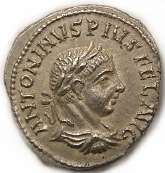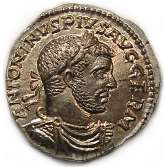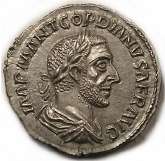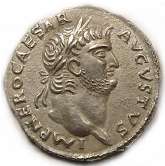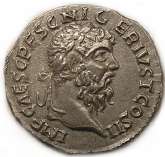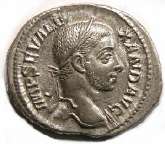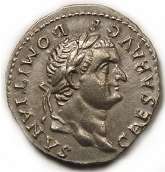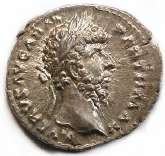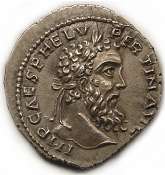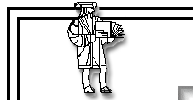 |
 |
|
SPOTTING FAKESThis page is mostly about how new fakes are spotted as they entering the market, usually very quickly. It will not make you an expert in spotting fakes but will give you some basic information you can build on. Some of the observations do not prove the coin is fake, but show further investigation is needed. Others show proof a coin is fake. If you have not already done so, I suggest you first read the preceding pages on types of fakes, as much of what follows builds on them. WeightThe majority of genuine ancient coins were stuck to specific weight standards. Ancient minting was not exact so there is always some variation between specimens, but in most cases it is limited. A coin too heavy or light relative to the expected standard cannot be automatically condemned but should be investigated further. A type with very narrow range is the Persian siglos struck after 485 BC for which specimens are between 5.35 and 5.60 grams and any specimen outside of that should be investigated further. Only rarely will a genuine example be outside that range. Always remember that many fakes will be of their correct weight, so correct weight does not prove authenticity. Incorrect with warrants further investigation. Another example are tetradrachms of Athens where the typical range is from 16.60 to 17.3 grams. For every type it is not difficult to research what the expected range should be, but there are some types with it is much broader and for those this is a less useful gauge of authenticity. SizeAugustus struck Gaius and Lucius coins as both silver denarii and gold aureii, with specific dies for each denomination. The size of the coins vary considerable due to imperfect Roman flan production methods, but Roman die cutting was more careful with the beaded border of the aureus dies 19 to 19.5 mm across and denarii dies 18. Forgers somtimes cut dies of incorrect size while occasionally using the same dies for more than one denomination so some of them is wrong. Some ancient coins were struck to specific size and weight standards while others were not. It takes both experience and research to understand if a coin needs further investigation because of its size or weight, but this can be useful a useful tool. Almost Identical Examples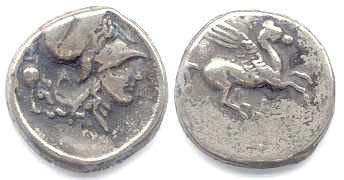
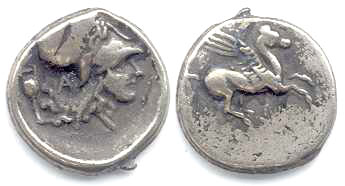
Ancient minting involved mostly handwork which does not lend itself to minting nearly identical coins. Two coins struck moments a part of the same set of die can have different centering, flan shapes and striking quality and two as identical as these fake Corinthian staters made in permanent molds, is next to impossible. I have seen several dozen of this exact fake all this identical and any time you see two ancient coins this close there is reason for suspicion. Too Many from the Same Dies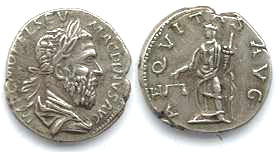
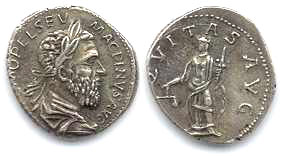
These Macrinus denarii were struck with the same die pair on flans of different shapes. A forger die striking has not trouble varying his flan shape, die axis, centering, and other striking characteristics. I have seen many examples from this die pair and while that does not prove they are fakes it warrants further investigation. In this case, the style is incorrect which shows they are fakes. I once saw about eighty mint state Trajan Decius antoninianii with about 20% struck from one die pair. Individually they looked good and it was only so many from one die pair that warranted further investigation which determined they were genuine. Mint state coins that travel from the mint to one owner and are then buried together will occasionally have this pattern, but it is unusual. Large Hoards With Insufficient Die VariationsHow long ancient dies lasted is unknown and probably inconsistent, but it was probably somewhere between 10,000 and 30,000 coins with some dies breaking far earlier and some lasting longer. I will assume an average of 20,000 for what follows, but really does not matter if it was 2000 or 30,000 for the principle of what will be discussed Hammer striking heats dies which causes die stress and deterioration. Die links suggest mints sometimes used multiple die pairs together, mixing and matching as needed, so dies had time to cool after getting hot. If dies last an average of 20,000 strikes and issue of 100,000 coins with 5 die pairs has the possibility of twenty-five die pair combinations. With use the dies wear, so the number of combinations increases dramatically if for a particular die its fresh new state is considered different than its worn state. In a large mint state hoard there will be some matched pairs, but also much variation. Many types of ancient coins were minted by the millions so there are hundreds of dies involved. While in mint state hoards matched die pairs are possible, one coins enter into circulation the pairs get separated and mixed in with many others including many other types. Coins worn to a grade of VF would have circulated for a decade or more, those in Fine several decades, and those in VG a century or more. The chances of finding two coins from the same die pair reduces dramatically with the length of time they are in circulation. If a large group coins with of matched die pairs show up heavily circulated, the odds they will be genuine is very low. Very large issues of coins may have been in the millions with hundreds of dies involved. Finding matched die pairs in mint state hoards is expected, but coin have seen more mixing of dies pairs. Coins worn to VF circulated for a decade or more, those in Fine several decades, and those in VG a century or more and over those times chances of two coins from the same die pair staying together is dramatically reduced. The more common the type, the more likely this is. Years ago I was shown and intact hoard of over 500 circulated 2nd to 3rd century Roman denarii and did not notice any die matches, and that that many coins that were even the same type. Another time I saw a hoard of about 100 Severus Alexander denarii in gVF to XF so had not been in circulation long, and could not find 10 die matches. Genuine Mesembrian diobols are common and finding two from the same die pair is difficult. Some years back hundreds of what appeared to be lightly circulated examples appeared in Germany, all struck from only six die pairs. That is a near impossibly pattern for a common issue, and they were quickly dismissed as faked and published in The Celator magazine (I believe the article was by Frank Kovak). It was discovered they were original sold as reproductions in the gift shop of the Sophia Bulgaria Museum. No Previous Die HistoryAny very common coins struck in large numbers will usually be known from many hoards and on published examples of any of the dies should not be difficult. A new group coming on the market should share many of those dies so be easy to die match. In 1999 a hoard of over 5000 Apollonia Pontica Gorgon head drachms came on the market. The average grade was VF showing enough circulation should be good die dispersion with most if not all dies involved easy to match to previously known specimens. A die study determined there were about 62 dies (31 die pairs), not one of which of which could be matched to any previously known coin. This was clearly a hoard of fakes from newly made dies. One needs to be more careful with a die study of a rare type where the mintage was small with very few dies involved so nearly all specimens coming from only a handful of dies, and on occasion a hoard of that type might only show a few die pairs (sometimes only one). Die studies are an authentication tool to be used carefully by experienced numismatists. Stylistic ProblemsAs discussed previously on my page about struck fakes, copying the image of a coin is easy, capturing the style of that coin is nearly impossible without using casting or impression dies which have their own problems. Among the images below are two are genuine and seven fake coins.
Placing your mouse over each image should bring up either genuine or fake. I find even novice collectors with limited usually have little problem spotting which is which. If you had trouble with this I recommend reviewing images of various similar coins in either COIN ARCHIVES or WILDWINDS and then have another look at them. With experience spotting coins of incorrect style will become second nature. If you are on a mobile device without a mouse, but genuine coins are the Severus Alexander and the Lucius Verus. Same Die cutter on Coins Too Many Years ApartIt is unlikely any one ancient celator worked more than 25 years and my own study suggests an average of 15 to 20 years. Just as each ancient celator had his own style, so does each modern forger. Notice how similar these portraits are. 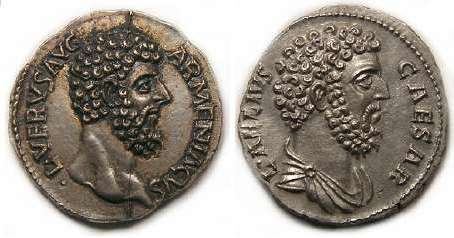 ENLARGEMENT These tow dies appear to be the work of one man, at about the same point in his artistic development. The Aelius on the right cannot have been struck after AD 137. The Lucius Verus on the left with the Armeniacus cannot be before AD 164. A 27 year difference is a stretch for an ancient celator, but impossibly for two dies at the same point in his artistic development. Based on this alone these coins cannot be genuine. Die Matches That Should Not ExistAs discussed previously, ancient Roman dies were probably used for less than 30,000 strikes which would only take a few days or perhaps a few weeks. In rare instances of one reverse die was used by two different emperors, but normally by co-emperors striking a joint coinage. Examples of dies that for one reason or another were set aside and used again years later exist but are very unusual and most people will never encounter such. Now look at these two coins clearly struck from the same reverse die. 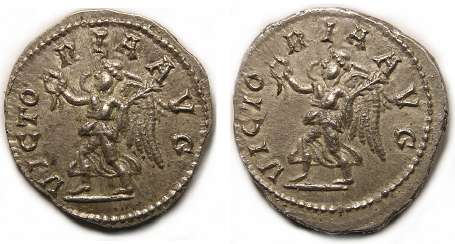 ENLARGEMENT The coin on the left is a Maximinus I which could not have been struck prior to AD 235. That on the right is an Elagabalus of a type struck prior to AD 222. The same reverse die used on coins at least 13 years a part is nearly impossible in an official ancient mint. Such matches are occasionally found on ancient but counterfeit coins for the same reason they turn up on modern fakes struck a modern workshops. One Celator, Too Few DiesContrary to what many think, most ancient dies took only a few hours to cut. An ancient celator cutting on average 2 sets of dies per day, perhaps 300 days a year for 15 years would have cut about 9000 die pairs. A very large issue of coins could involve many dies but all cut by a very small number of celators. Each celators style is be seen on many so many coins they become easily recognizable 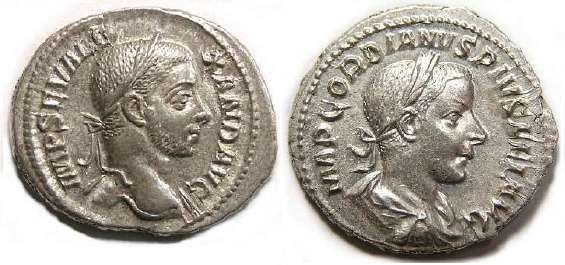
The denarius on the left is of Severus Alexander in a style that first appears about AD 228 and cannot have been struck after AD 235. That on the right is a genuine denarius of Gordian III of this style that is not seen after about AD 242 and cannot have been struck before AD 238. The style is so close they have to be the work of the same celator, with a maximum of 14 years between them. The Gordian shows a slightly finer artistic skill as one might expected with the several years and perhaps thousands of dies he cut between them. If you do a little research you will find his style for many of dies of Severus Alexander, Maximinus I, Gordian I and II, Balbinus, Pupienus, and Gordian III all struck at Rome during that period. He worked for about 14 years cutting dies for all Emperors so is likely to have cut upwards of 4200 die. This is a normal pattern of genuine work by an official ancient celator. Look back at the fake Lucius Verus and Aelius above. If you do the research you will not be able to find any stylistic matches to them amount known genuine coins, and if you search data bases of fake coins you might find a few dozen dies by this hand. That very limited number of dies is normal pattern for a modern forger. The Common ThreadWhat you have just been introduced to is how most fakes have major inconsistencies with what is expected of genuine coins. I have only covered some of the highlights here, and used examples of fakes which are fairly obvious so that novices can see the principles involved. As your experience and knowledge grow more aspects of this will come clear to you. All but the most sophisticated fakes will become obvious almost at a glance. But that experience only comes with time and some effort. Be careful about condemning coins too quickly until you have it. When it comes to the most sophisticated fakes such as the Katane tetradrachm I mentioned on the struck fakes page, and discuss in detail on my examples section, they can be very difficult to spot and sometimes get pass through the hands of a few experts before they are spotted. None of us are 100% immune to making a mistake. But all will eventually be spotted. Fakes that good are not of concern to the average collector because they are every difficult and time consuming to make. If the forger goes through all that trouble and make a significant number of them suspicions will be raised. Often they only make a handful of them, and sometimes only one. They will not do that for the lower values coins most people collect. Most will be types worth more than $50,000. There is no such thing as a perfect fake.Next page: BOOKS ABOUT FAKES Copyright © 2016 R & T Enterprises Ltd. |
